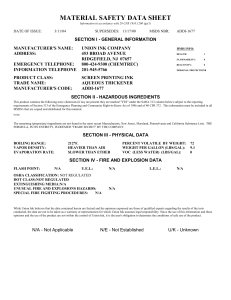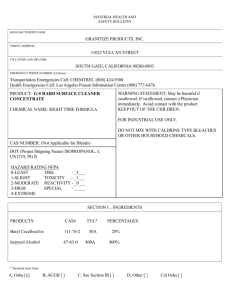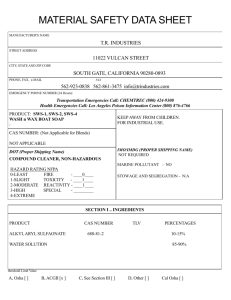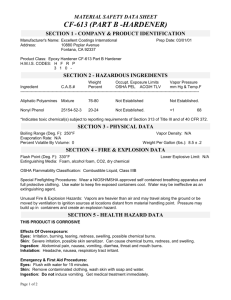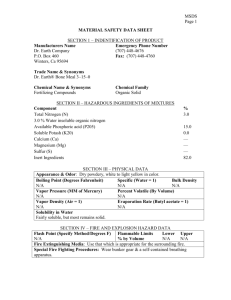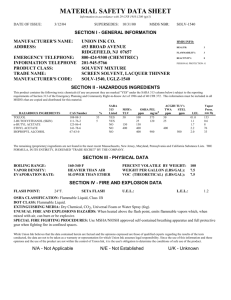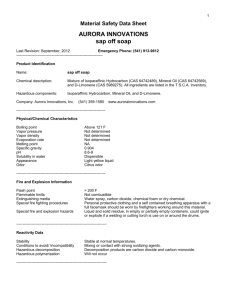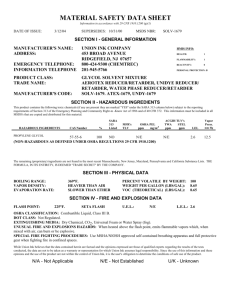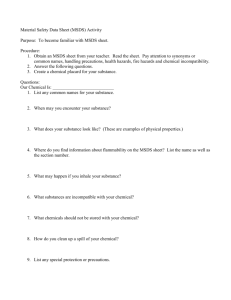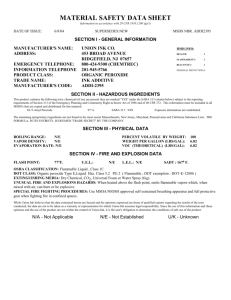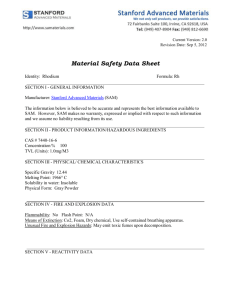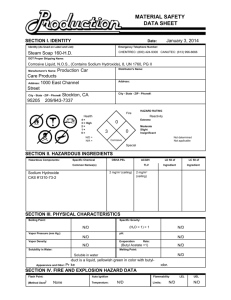NEW PLASTISOL MSDS - Union Ink Company
advertisement
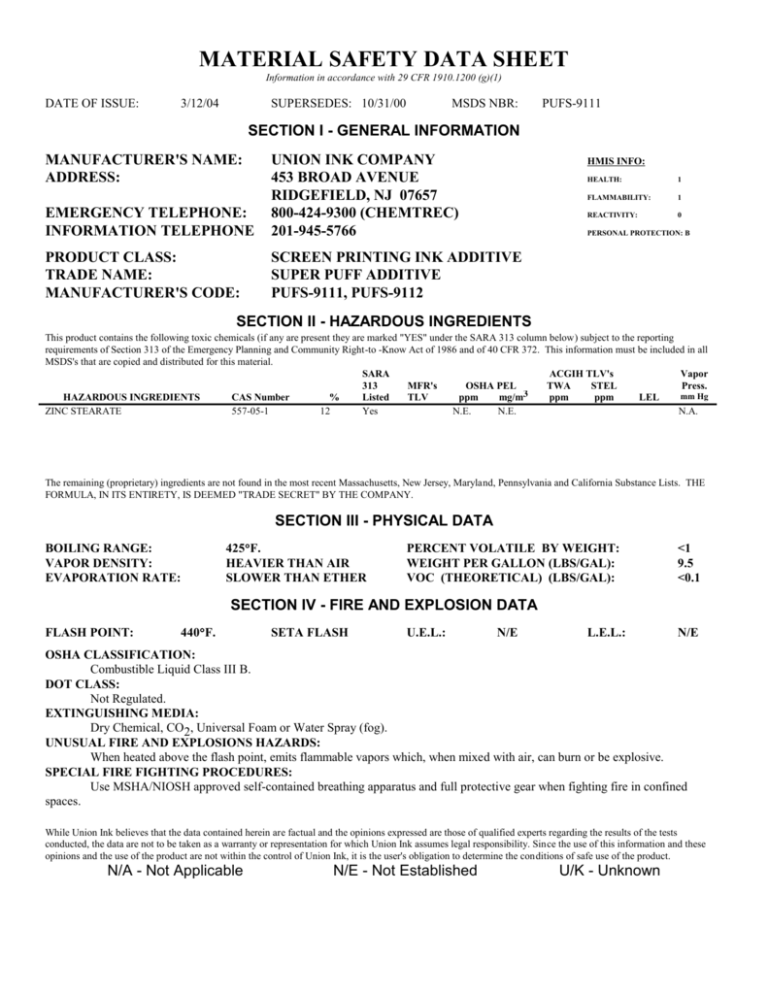
MATERIAL SAFETY DATA SHEET Information in accordance with 29 CFR 1910.1200 (g)(1) DATE OF ISSUE: 3/12/04 SUPERSEDES: 10/31/00 MSDS NBR: PUFS-9111 SECTION I - GENERAL INFORMATION MANUFACTURER'S NAME: ADDRESS: EMERGENCY TELEPHONE: INFORMATION TELEPHONE UNION INK COMPANY 453 BROAD AVENUE RIDGEFIELD, NJ 07657 800-424-9300 (CHEMTREC) 201-945-5766 PRODUCT CLASS: TRADE NAME: MANUFACTURER'S CODE: SCREEN PRINTING INK ADDITIVE SUPER PUFF ADDITIVE PUFS-9111, PUFS-9112 HMIS INFO: HEALTH: 1 FLAMMABILITY: 1 REACTIVITY: 0 PERSONAL PROTECTION: B SECTION II - HAZARDOUS INGREDIENTS This product contains the following toxic chemicals (if any are present they are marked "YES" under the SARA 313 column below) subject to the reporting requirements of Section 313 of the Emergency Planning and Community Right-to -Know Act of 1986 and of 40 CFR 372. This information must be included in all MSDS's that are copied and distributed for this material. SARA ACGIH TLV's Vapor 313 MFR's OSHA PEL TWA STEL Press. mm Hg HAZARDOUS INGREDIENTS CAS Number % Listed TLV ppm mg/m3 ppm ppm LEL ZINC STEARATE 557-05-1 12 Yes N.E. N.E. N.A. The remaining (proprietary) ingredients are not found in the most recent Massachusetts, New Jersey, Maryland, Pennsylvania and California Substance Lists. THE FORMULA, IN ITS ENTIRETY, IS DEEMED "TRADE SECRET" BY THE COMPANY. SECTION III - PHYSICAL DATA BOILING RANGE: VAPOR DENSITY: EVAPORATION RATE: 425F. HEAVIER THAN AIR SLOWER THAN ETHER PERCENT VOLATILE BY WEIGHT: WEIGHT PER GALLON (LBS/GAL): VOC (THEORETICAL) (LBS/GAL): <1 9.5 <0.1 SECTION IV - FIRE AND EXPLOSION DATA FLASH POINT: 440F. SETA FLASH U.E.L.: N/E L.E.L.: N/E OSHA CLASSIFICATION: Combustible Liquid Class III B. DOT CLASS: Not Regulated. EXTINGUISHING MEDIA: Dry Chemical, CO2, Universal Foam or Water Spray (fog). UNUSUAL FIRE AND EXPLOSIONS HAZARDS: When heated above the flash point, emits flammable vapors which, when mixed with air, can burn or be explosive. SPECIAL FIRE FIGHTING PROCEDURES: Use MSHA/NIOSH approved self-contained breathing apparatus and full protective gear when fighting fire in confined spaces. While Union Ink believes that the data contained herein are factual and the opinions expressed are those of qualified experts regarding the results of the tests conducted, the data are not to be taken as a warranty or representation for which Union Ink assumes legal responsibility. Since the use of this information and these opinions and the use of the product are not within the control of Union Ink, it is the user's obligation to determine the conditions of safe use of the product. N/A - Not Applicable N/E - Not Established U/K - Unknown Page 2 - PUFS-9111 SECTION V - HEALTH HAZARD DATA PRIMARY ROUTE OF ENTRY: Dermal contact or open wound. MEDICAL CONDITIONS WHICH MIGHT BE AGGRAVATED: None expected. OVEREXPOSURE TO VAPOR MAY CAUSE:(ACUTE) No adverse effects are expected. However, because fumes are occasionally observed arising from fabrics which are being heat cured, it is suggested that in accordance with good industrial hygienic practice that all heat curing equipment should be properly vented and exhausted to prevent irritation to eyes, nose and throat. (These fumes often arise from sizings, starches and other coatings which have been earlier applied to the textiles being printed.) REPEATED OVEREXPOSURE TO VAPOR MAY CAUSE: (CHRONIC) Occupational exposure to this material has not been reported to cause significant adverse human health effect. On the basis of available information, exposure to the product is not expected to produce adverse human health effects when recommended ventilation and safety precautions are followed. EMERGENCY AND FIRST AID PROCEDURES: Handle in accordance with good industrial hygiene and safety practices including unnecessary exposure to eyes, skin and clothing. In case of eye contact, flush eyes with plenty of water for at least 15 minutes and SEE A PHYSICIAN. SECTION VI - REACTIVITY DATA STABILITY: Stable CONDITIONS TO AVOID: INCOMPATIBILITY Strong acids, alkalis, oxidizing agents. HAZARDOUS DECOMPOSITION PRODUCTS: Burning may produce oxides of Nitrogen, Carbon Dioxide/Monoxide. HAZARDOUS POLYMERIZATION: Will Not Occur. SECTION VII - SPILL OR LEAK PROCEDURES STEPS TO BE TAKEN IN CASE MATERIAL IS RELEASED OR SPILLED: Contain spill and pick up and transfer to containers for recovery if uncontaminated or disposal if contaminated. If necessary dike and contain spill with absorbent or inert material. WASTE DISPOSAL METHOD: Small amounts can be fused in a microwave or vented oven and disposed of as solid waste according to local, state, and federal regulations. (Do not use same ovens for cooking food.) SECTION VIII - SPECIAL PROTECTION INFORMATION VENTILATION: Use local or central exhaust systems to remove fumes which may arise during any heat curing operation. (These fumes often arise from sizings, starches and other coatings which have been earlier applied to the textiles being printed. RESPIRATORY PROTECTION: IN OPEN AREAS: Use approved mechanical filter respirator if there is not exhaust system in operation during any heat curing procedure. IN RESTRICTED VENTILATION AREAS: Use NIOSH/MSHA approved chemical/mechanical filter respirators or positive pressure air hoods if local mechanical exhaust is not sufficient. PROTECTIVE GLOVES: Impervious type required for prolonged or repeated contact (during mixing or when washing up). EYE PROTECTION: Use safety goggles or face shields (ANSI Z87.1 or equiv.). OTHER PROTECTIVE EQUIPMENT: Eye bath, safety shower, aprons. SECTION IX - SPECIAL PRECAUTIONS PRECAUTIONS TO BE TAKEN IN HANDLING AND STORING: KEEP AWAY FROM HEAT AND OPEN FLAME LIQUID MAY CAUSE EYE AND SKIN IRRITATION FOR INDUSTRIAL USE ONLY USE ONLY WITH ADEQUATE VENTILATION WASH HANDS THOROUGHLY AFTER USING KEEP OUT OF THE REACH OF CHILDREN DO NOT USE UNTIL MANUFACTURER'S SAFETY PRECAUTIONS HAVE BEEN READ AND UNDERSTOOD
